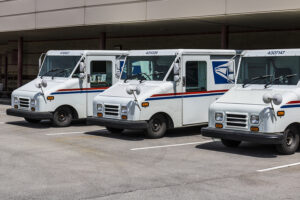The United States Postal Service (USPS) offers many great job opportunities especially during the holidays when it is critical for them to deliver mail, packages, and parcels on time. The city carrier assistant (CCA) and the rural carrier associate (RCA) are two of the most in demand jobs each holiday season.
All applicants must apply online to be considered for employment and have a valid email address. All communication regarding employment opportunities, examinations, interviews and background checks are sent by email. Add the following list of email domain addresses to your contact list or check you spam folder for these email extensions:
- @usps.gov
- @psionline.com
- @geninfo.com
- @uspsis.gov
Dennis Damp, host of PostalWork.net reports that many applicants miss out on opportunities because they don’t print out a copy of the Postal Service job announcement. The job announcement includes detailed application guidance. It also provides contact information in case you have a problem with the application process, need to reschedule an exam, or to confirm receipt of documents. Damp frequently receives questions from applicants that don’t know who to contact after applying for postal positions because they didn’t print out a copy of the job announcement.
City Carrier Assistant (CCA)
Generally CCAs are appointed for periods not-to-exceed 360 days. Subsequent appointments after a 5 day break in service may be offered but are not guaranteed. If your work performance is satisfactory there may be opportunities to apply for a permanent position. City Carrier Assistants must be U.S. citizens to apply, take an on line assessment and pass the 473 Postal Exam. The starting salary is $16.06 per hour paid bi-weekly.
Duties
- Routes or cases all classes of mail in sequence of delivery along an established route. Rearranges and re-labels cases as required.
- Withdraws mail from the distribution case and prepares it in sequence for efficient delivery independently or by another carrier along an established route. Prepares and separates all classes of mail to be carried by truck to relay boxes along route for subsequent delivery.
- Handles undeliverable mail in accordance with established procedures.
- Delivers mail along a prescribed route, on foot or by vehicle, on a regular schedule, picking up additional mail from relay boxes as needed. Collects mail from street letter boxes and accepts letters from mailing from customers; on certain routes may deliver mail that consists exclusively of parcel post, or the collection of mail.
- Uses portable electronic scanner as instructed.
- Delivers and collects charges on customs, postage-due, and C.O.D. mail matter. Delivers and obtains receipts for registered and certain insured mail. Signs for such matter, except insured mail, at the post office before beginning route and accounts for it upon return by payments of the amounts collected and delivery of receipts taken.
- Deposits in the post office mail collected on the route upon returning from the route.
- Checks, and corrects if necessary, mailing cards from advertisers bearing names and addresses of customers or former customers on the route.
- Furnishes customers with postal information and provides change of address cards and other postal forms as needed.
- Reports to supervisor all unusual incidents or conditions relating to mail delivery, including condition of street letter boxes and centralized delivery equipment.
- Becomes proficient, when assigned to a route, in the casing of mail on other routes as assigned.
- Works professionally with other employees in the office.
- May as a CCA, perform clerical duties and be required to pass examinations on scheme of city primary distribution.
- In addition, may perform any of the following duties: check hotels and other establishments to ensure that mail for residents undeliverable as addressed is not improperly held; deliver stamps or other paper supplies to contract or classified stations and other designated delivery points; serves at carriers’ delivery window; receive and register where practical, all letters and packages of first-class matter properly offered for registration; case mail and make deliveries on other routes as assigned.
Physical Requirements
You must be physically able to efficiently perform the duties of the position with or without reasonable accommodation. CCA duties require arduous exertion involving prolonged standing, walking, bending and reaching, and may involve handling heavy containers of mail weighing up to the allowable maximum mailing weight.
Additional Requirements
CCAs must work their assigned tour and days of work. CCAs must follow Postal Service policies and procedures for personal conduct at work, including adhering to rules and regulations.
CCAs are required to provide service to the public. They must maintain a neat and professional appearance and demeanor in such interactions. May be required to wear uniform items.
Applicants must have a valid state driver’s license, and demonstrate and maintain a safe driving record.
Associate Rural Carrier (ARC)
- Must be a U.S. citizen to apply.
- On line assessment and a written Exam Required: Postal Exam 473 is required.
- $17.02 per hour paid bi-weekly.
Duties
- Loads packages in delivery sequence in vehicle.
- Delivers packages to customers along a prescribed route.
- Sorts mail in delivery sequence for the assigned route.
- Receives and signs for accountable mail.
- Loads mail and packages in vehicle.
- Delivers mail and packages to customers along a prescribed route or as an auxiliary assistant by a vehicle; collects monies and receipts for accountable mail; picks up mail from customers’ roadside boxes.
- Furnishes routine information concerning postal matters to customer.
- Returns mail collected, undeliverable mail, and submits monies and receipts to post office.
- Prepares appropriate time records.
- Provides for mail security at alltimes.
- May be required to provide a vehicle for delivery if an employer provided vehicle is not assigned.
They are non-career employees who provide customers along a rural route services which includes delivering and collecting mail.
Work is performed indoors and outdoors in all types of weather. Carriers may be required to load and unload trays and containers of mail and parcels weighing as much as 70 pounds.
For more information, review our step-by-step guide for applying for and taking the exam. A postal exam study guide titled Post Office Jobs, the 6th edition, can help you prepare for the exam.
Additional Information from the OOH website
Postal service mail carriers deliver mail to homes and businesses in cities, towns, and rural areas. Most travel established routes, delivering and collecting mail. Carriers cover their routes by foot, vehicle, or a combination of both. Some mail carriers collect money for postage due. Others, particularly in rural areas, sell postal products, such as stamps and money orders. All carriers must be able to answer customers’ questions about postal regulations and services and, upon request, provide change-of-address cards and other postal forms.
All applicants must pass a written exam that measures speed and accuracy at checking names and numbers and the ability to memorize mail distribution procedures. Jobseekers should contact the post office or mail processing center where they want to work to find out when exams are given.
When accepted, applicants must undergo a criminal background check and pass a physical exam and a drug test. Applicants also may be asked to show that they can lift and handle heavy mail sacks. Mail carriers who drive at work must have a safe driving record, and applicants must receive a passing grade on a road test.
Other Qualities
Customer-service skills
Postal service workers, particularly clerks, regularly interact with customers. As a result, they must be courteous and tactful and provide good client service.
Physical stamina
Postal service workers, particularly carriers, must be able to stand or walk for long periods.
Physical strength
Postal service workers must be able to lift heavy mail bags and parcels without injuring themselves
Union Membership
Most postal service workers belonged to a union in 2014.
These were just two of the many wonderful job opportunities offered by the USPS.
Credit
Helpful Career Planning Tools
Visit our other informative site
The information provided may not cover all aspects of unique or special circumstances, federal and postal regulations, and programs are subject to change. Our articles and replies are time sensitive. Over time, various dynamic human resource guidance and factors relied upon as a basis for this article may change. The advice and strategies contained herein may not be suitable for your situation and this service is not affiliated with OPM, the postal service or any federal entity. You should consult with school counselors, hiring agency personnel offices, and human resource professionals where appropriate. Neither the publisher or author shall be liable for any loss or any other commercial damages, including but not limited to special, incidental, consequential, or other damages.









